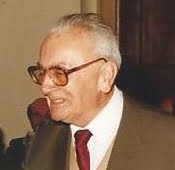Hugó Homonnay
After graduating from the Ludovika Academy, he worked in the military until the spring of 1946. From 1946 to 1948, he worked for the National Federation of Industrialists. In 1948, he graduated in economics, and in the same year, he received his doctorate from Farkas Heller; his dissertation was titled: How the price mechanism can be replaced in a planned economy.
In 1949, he worked at the Heavy Industry Center. From 1950, he worked on developing industrial company methodologies at the Office Automation Economic Office (IGI).
He was arrested in the spring of 1951 and then interned. From the fall of 1953 he was an agricultural worker; later he was occasionally allowed to do economic work. He was rehabilitated in the summer of 1956, and then became an accounting organizer at the Csepel Car Factory.
From 1958, he designed and manufactured punched card systems at the Machine Data Processing Company. From 1960, he worked at Ganz-MÁVAG, on the unification of the two factories that were then merged: his task was to develop a unified work number system and create unified punched card processing systems.
He worked at the Central Statistical Office (KSH) from 1963. The Computer and Administrative Management Company (SZÜV) was formed partly from the employees there, to which he also transferred. As a proposer, he was involved in Hungary acquiring the then most modern (the first multiprogramming) ICT 1900 computers in the second half of the 1960s.
In 1966-67 he was a member of the Information Processing Laboratory (Infelor).
In 1960, he obtained the qualification of expert in machine data processing, and then in 1972, expert in information processing systems. From the 1960s, he taught punched card, the so-called middle machine (accounting machine), and then computer programming and organization. He wrote several textbooks. He really loved education. He also tried to embrace his young colleagues in his workplaces.
From 1967 he worked at the Computer Center of the Ministry of Internal Trade (KERINFORG). He designed and created computer processing for many internal trade companies – from 1968 on the new Honeywell computer.
He was employed by DATORG from 1973. He retired from there in 1975. After that, he worked as an expert at DATORG for a few more years and then at Ferroglobusz.
He was one of the founding members of the Hungarian Society of Organizational and Management Studies (NJSZT). He was also a member of the Hungarian Society of Organizational and Management Studies (SZVT).
His awards: Hevesi Gyula Medal (SZVT, 1978); Memorial Medal for an Independent Democratic Hungary (1992); Neumann Prize (NJSZT, 1993).
Created: 2016.06.28. 23:04
Last modified: 2023.11.26. 13:11

